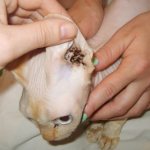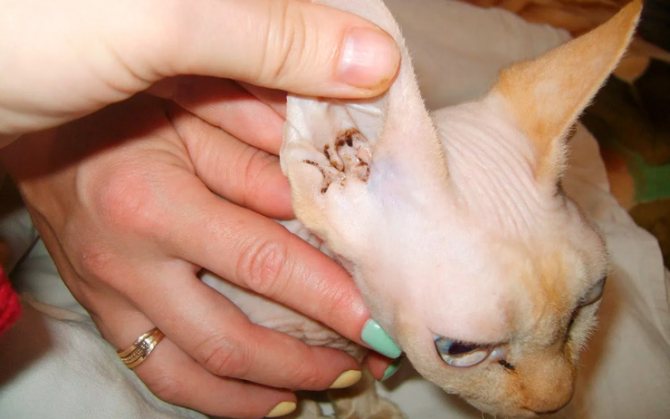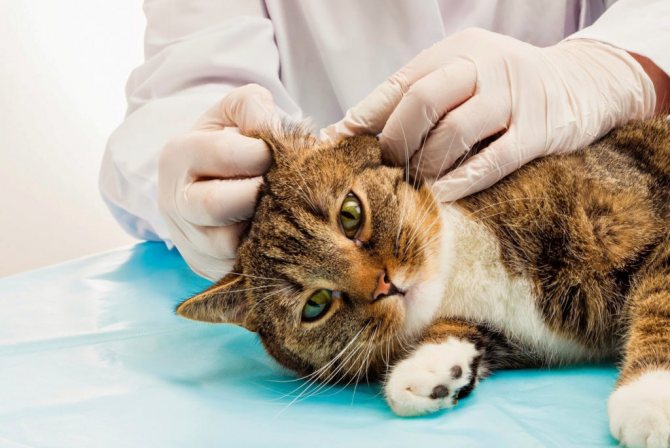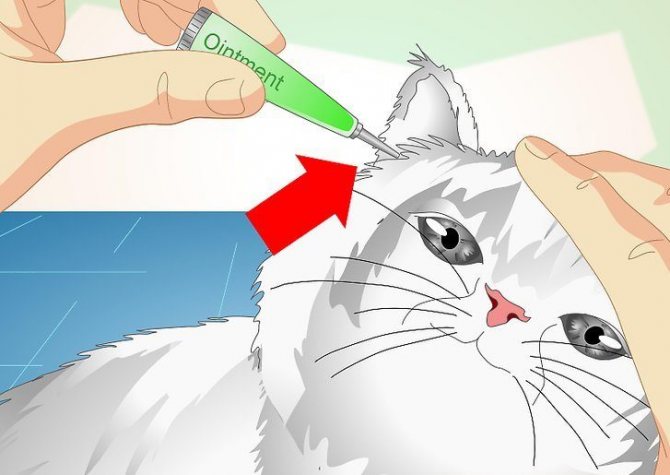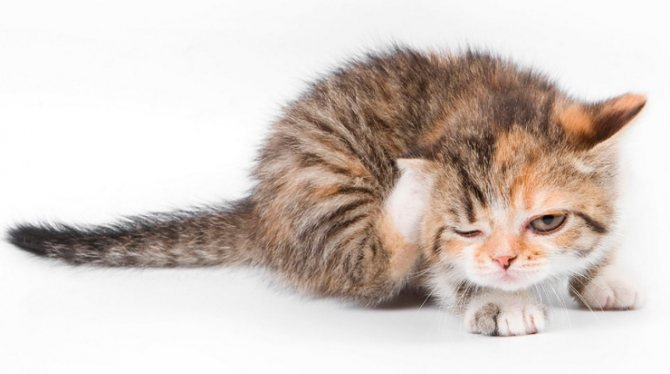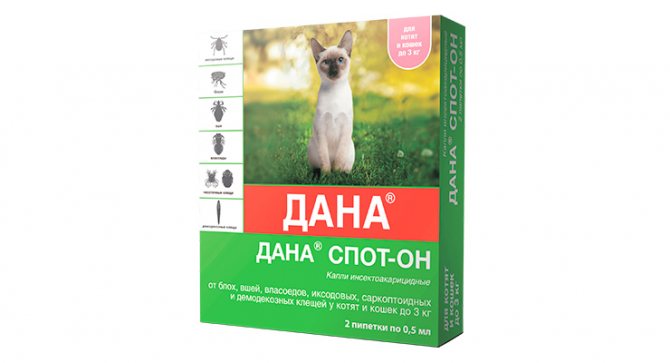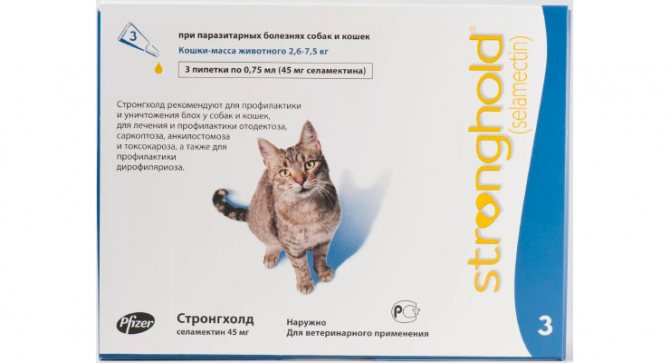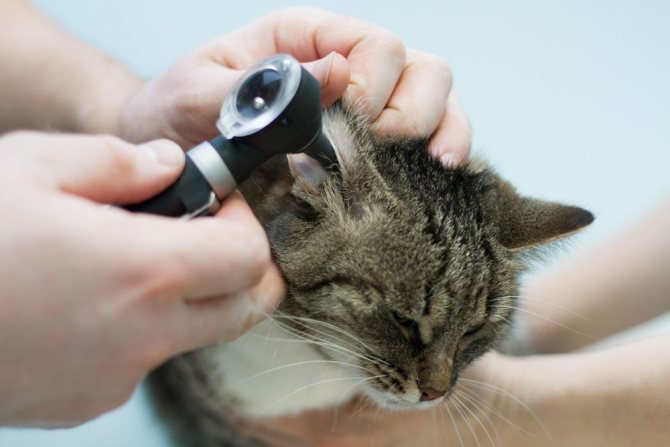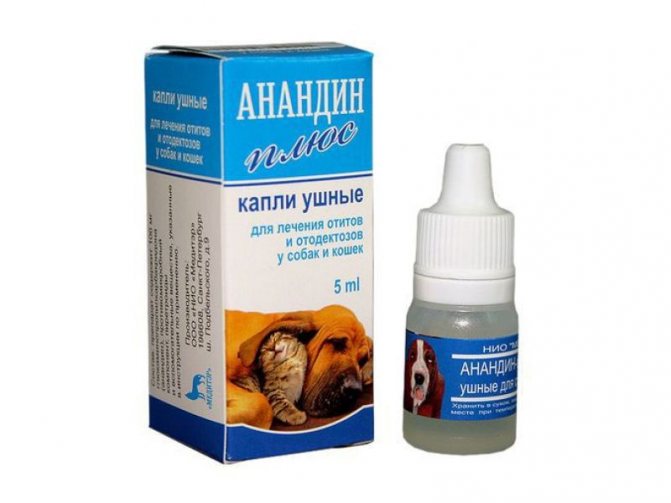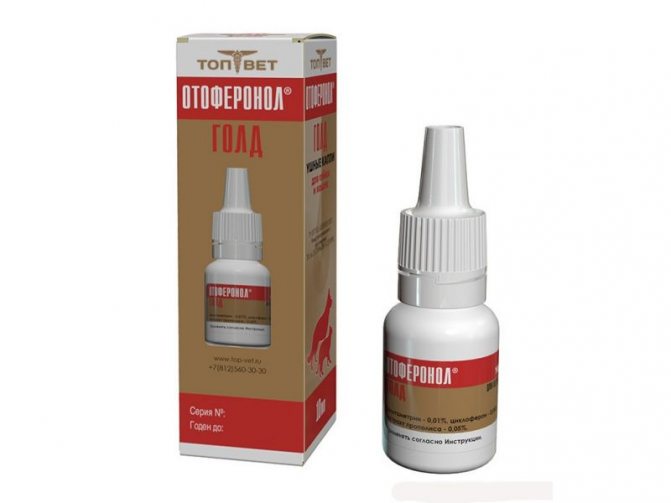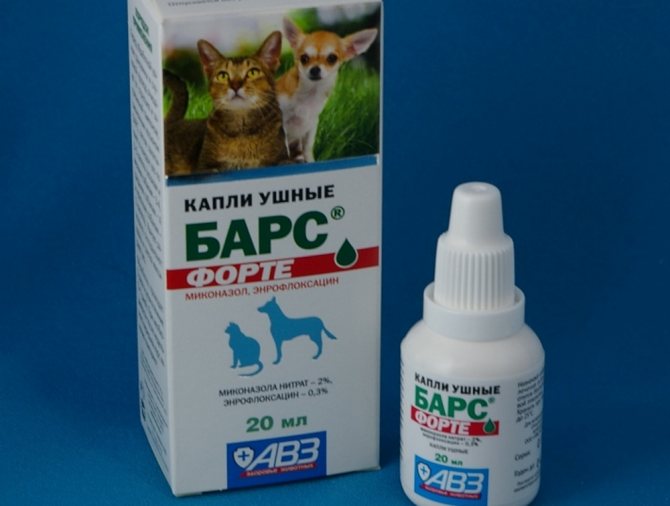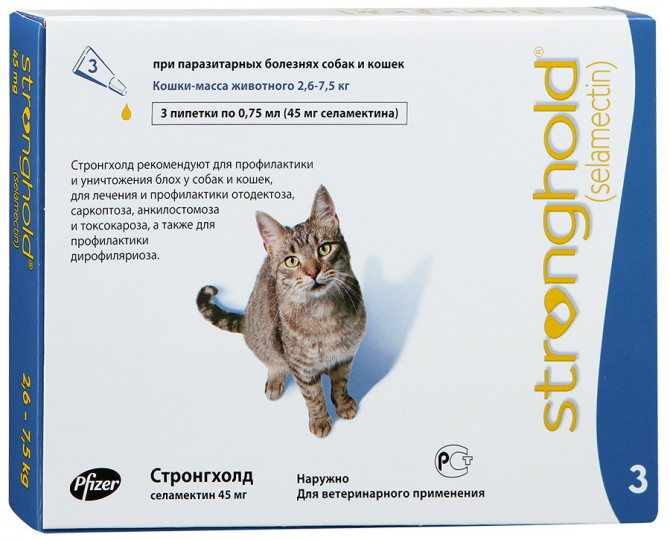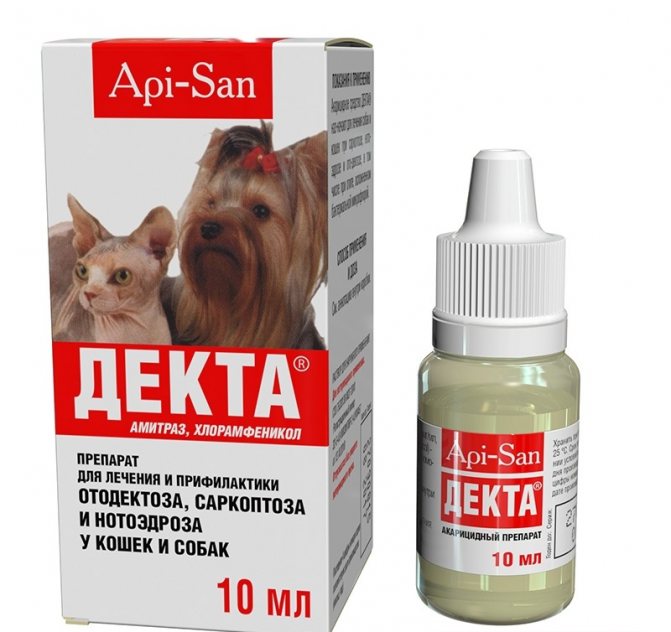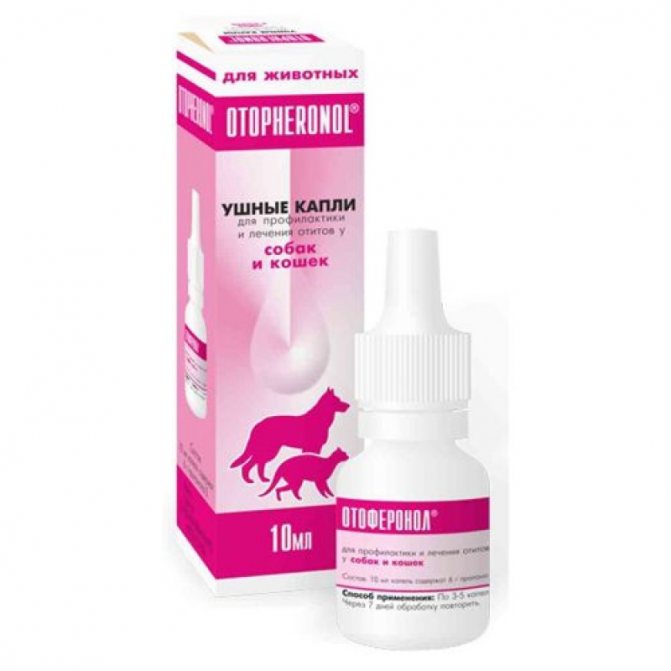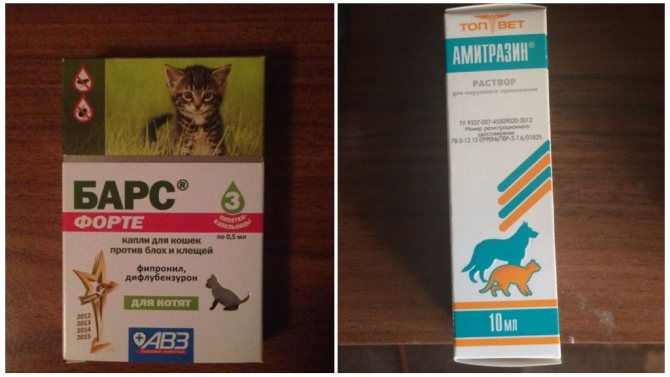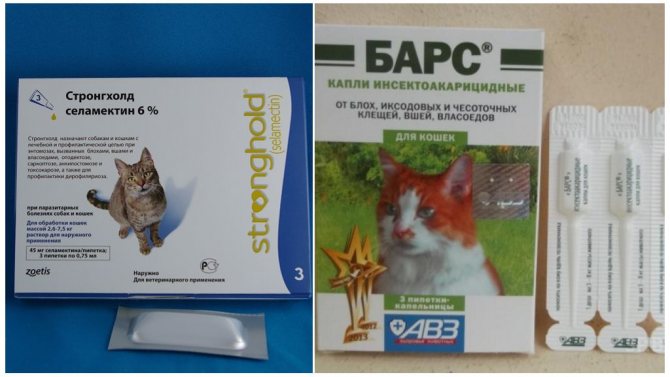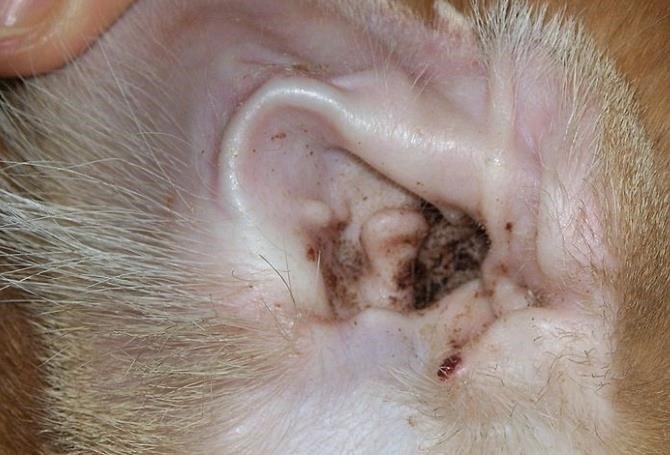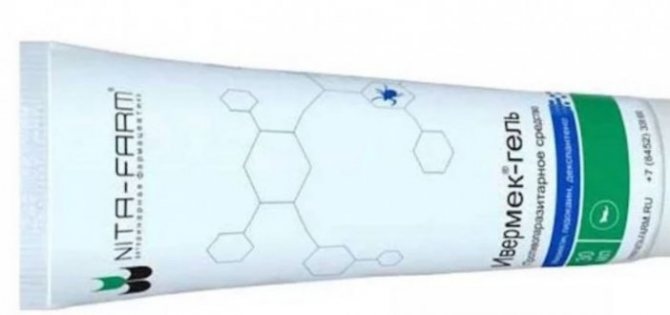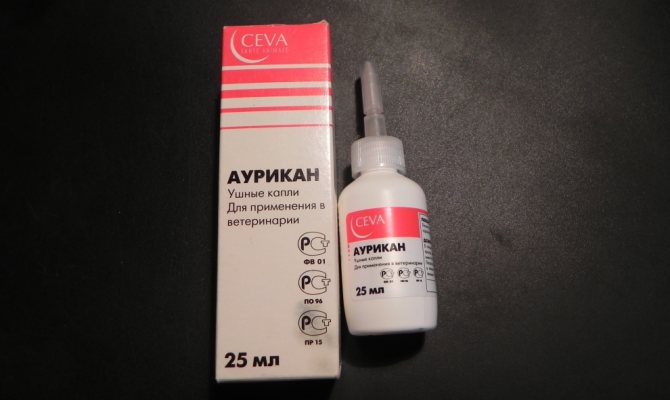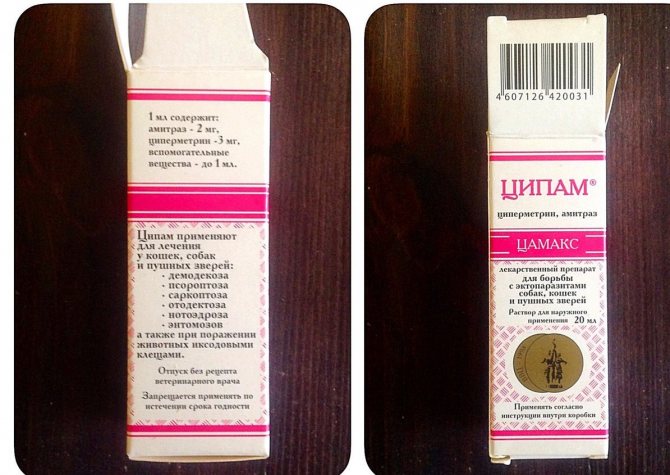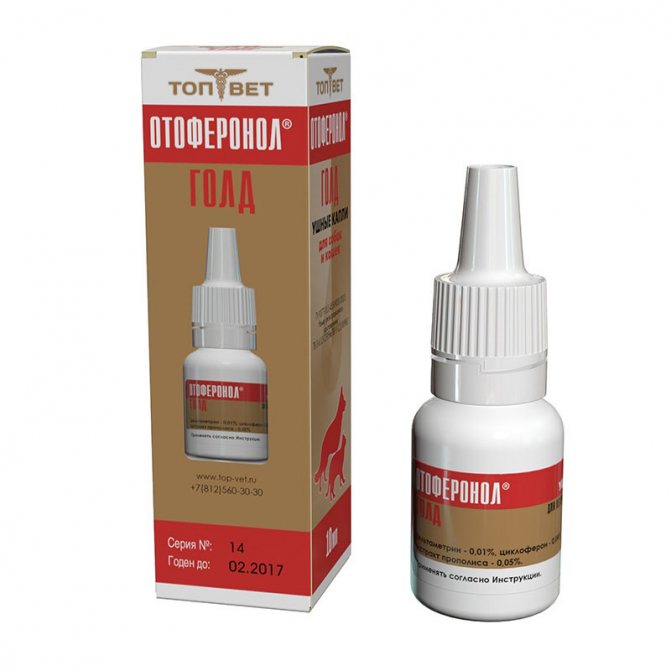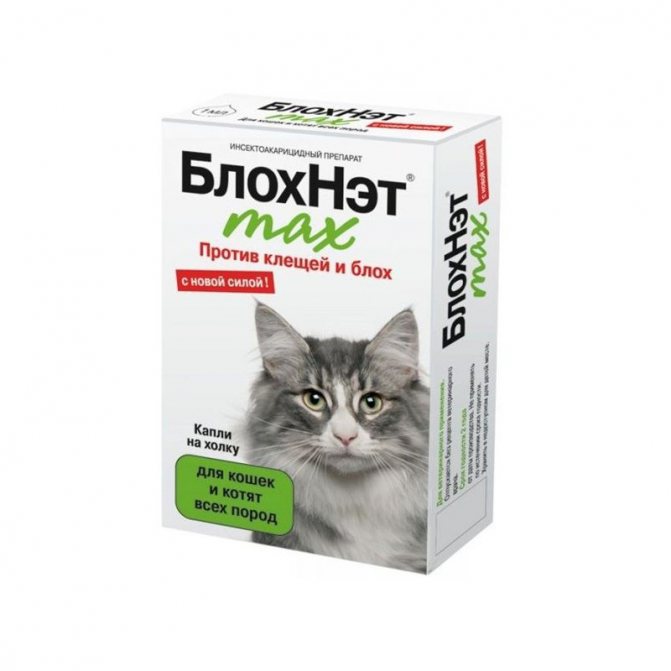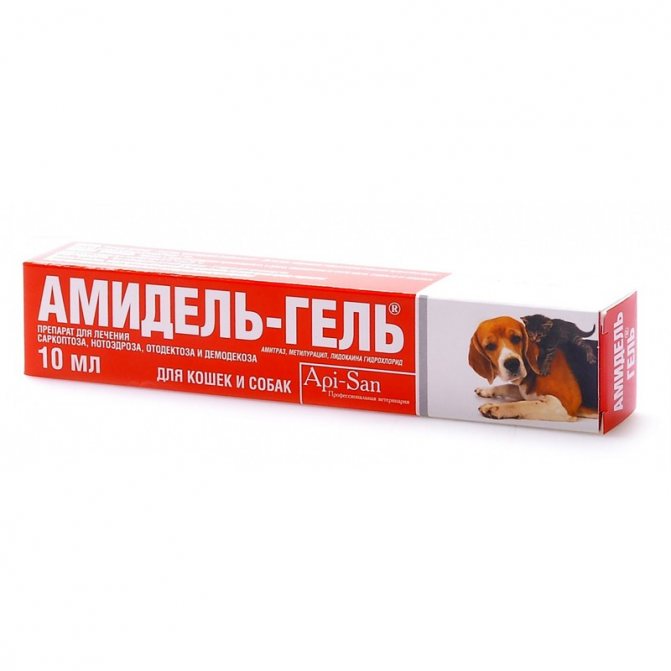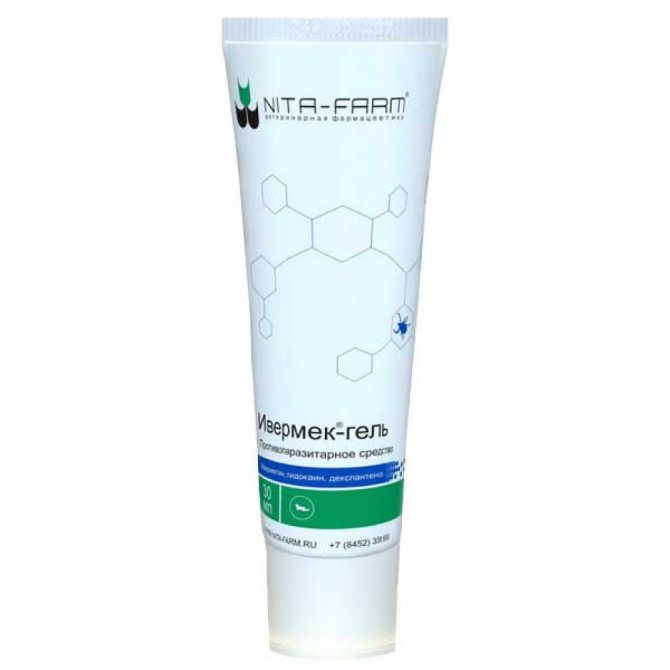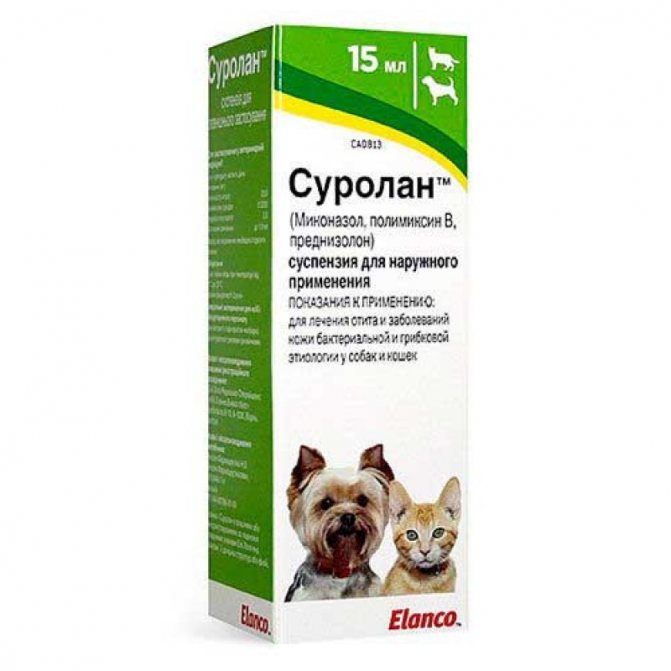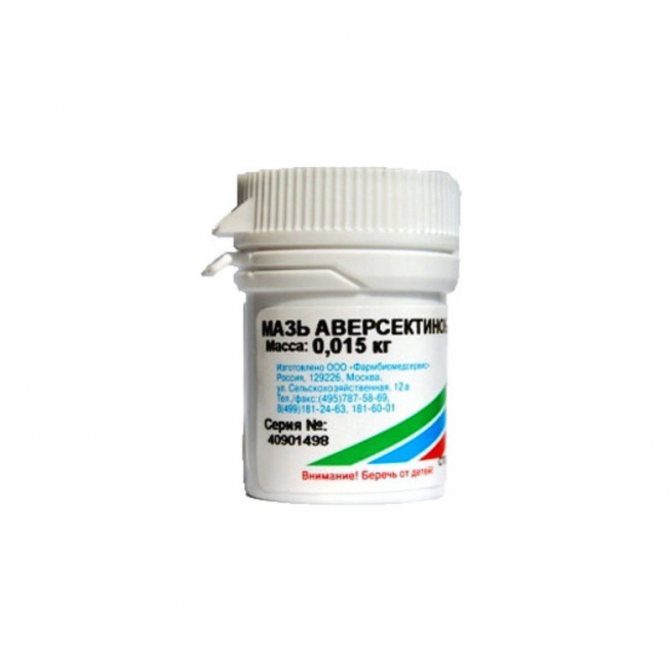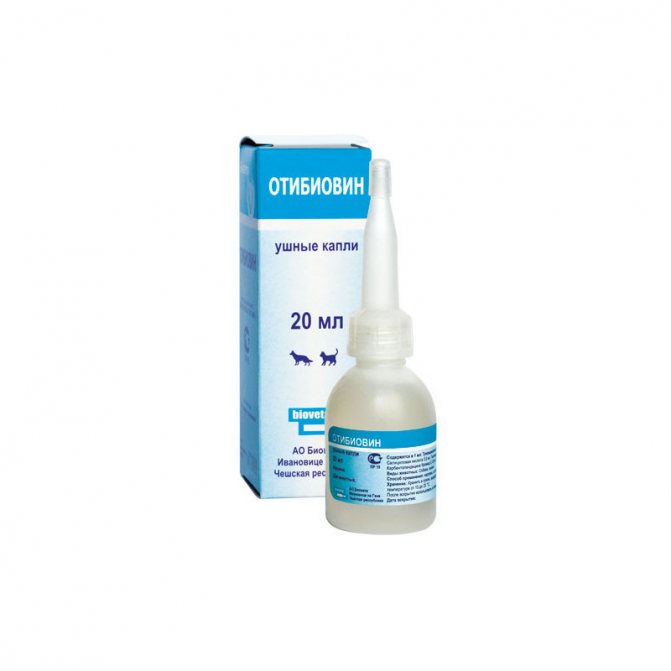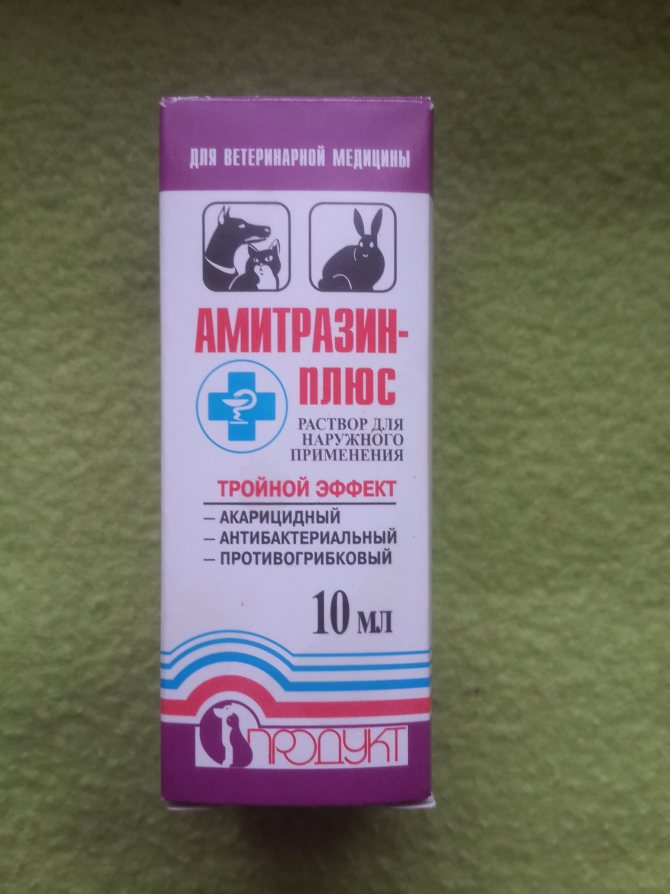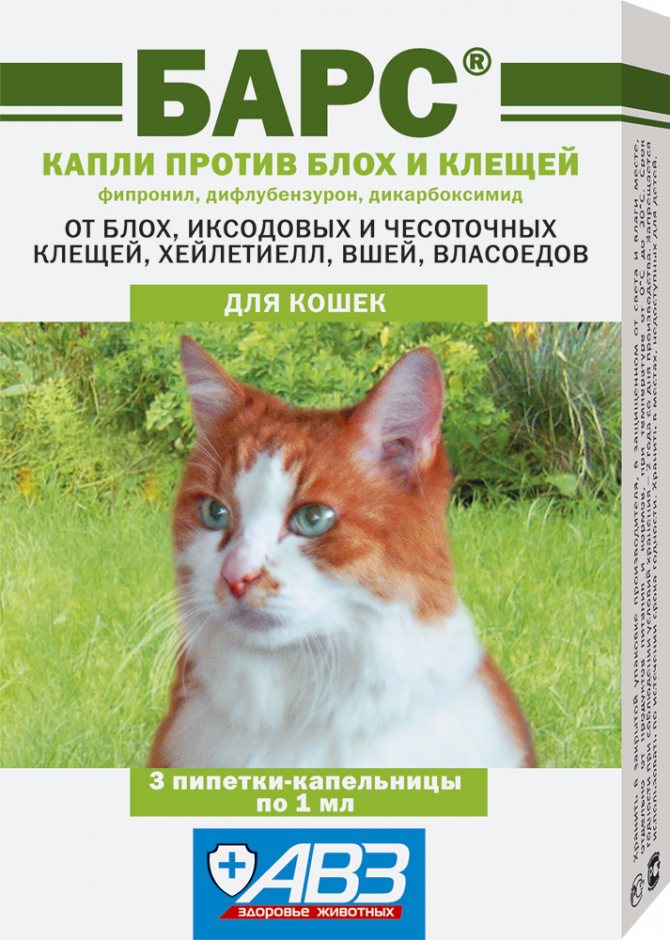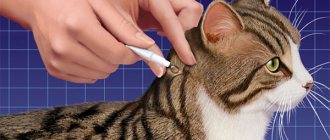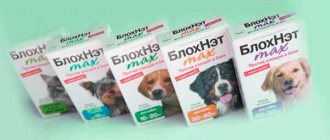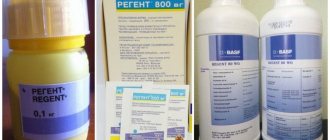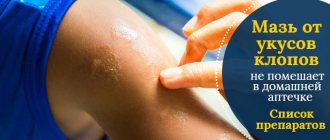Otodectosis - ear mites or ear scabies - is a rather unpleasant disease that requires competent and correct treatment and does not accept initiative on the part of the owners. Drops from an ear mite for cats are prescribed only by a specialist, based on what will be found during the examination of the auricle at the reception: how much the process is running, whether it is otodectosis at all, what can be seen under a microscope in a smear of secretions, whether a bacterial infection has joined, whether the tympanic is damaged membrane, etc.
Behavior of a cat with an ear mite
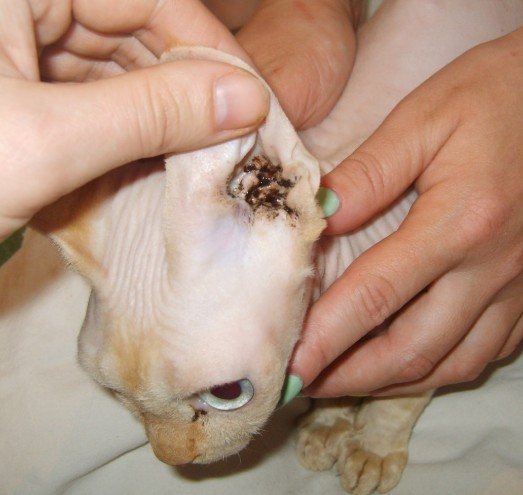
Ear mite in a cat
It is possible to identify a disease in a pet by its characteristic signs.because insects affect both ears at the same time. The provoking factors of their spread are moisture and heat.
When the ear canal is damaged, an inflammatory process occurs, which contributes to the abundant discharge of pus. This causes serious discomfort to the pet, and the discomfort is annoying all the time.
To identify the disease, it is enough to observe the behavior of the cat, check the ears for the presence of waste products of the parasite.
Characteristic signs of illness affecting behavior:
- the cat becomes restless, cannot lie in one place;
- periodically shakes his head, meows plaintively;
- presses against the owner, tilting his head to the side;
- periodically scratches ears on corners and furniture.
You can also detect infection by the presence of purulent discharge.that accumulate in the auricle, and on the characteristic brown crusts directly in the ear or near it.
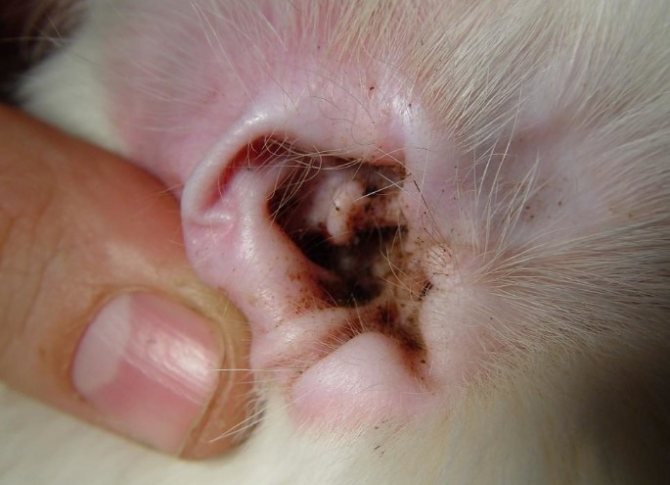

You can also detect infection by the presence of purulent discharge.
Lack of treatment leads to the penetration of the pathological process into the middle and inner ear, then the disease switches to the lining of the brain, which threatens with serious health complications.
Symptoms of an advanced form of otodectosis:
- high temperature;
- dejected state;
- the head is constantly tilted towards the affected auricle;
- periodic seizures.
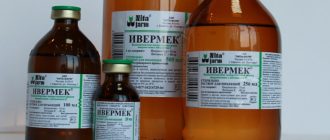

Be sure to read:
The drug Ivermek, instructions for use for cats: dosages and composition
A neglected form of the disease can cause death, so it is necessary to check the ears of the animal and respond in time to the unusual behavior of your pet.
Clinical picture
For cat owners, the appearance of a tick in their pet will not go unnoticed. Of the main symptoms of the onset of the problem, the following can be noted: ● The appearance of purulent liquid discharge from the ears. ● The presence of suppuration. ● A dark, foul-smelling coating appears in the ears. ● Frequent head shaking. ● Obsessive itching appears in the ears of cats. ● Obvious concern of the animal.
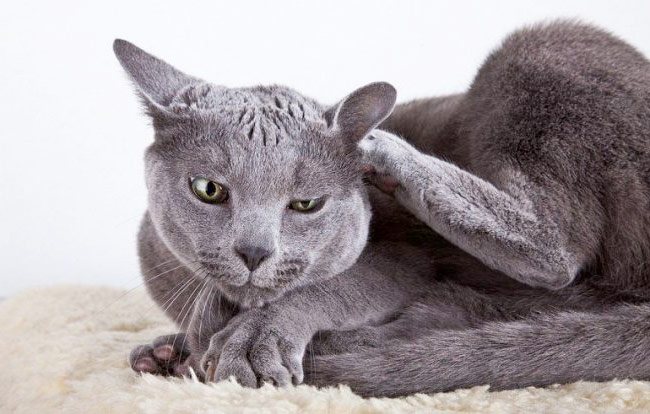

If you notice these symptoms of ear mites, you should consult your veterinarian. Remember that only a specialist using special equipment will be able to make a diagnosis, which will be the key to quality therapy. Self-medication in this case can only lead to an aggravation of the problem.
What are the most effective remedies for a tick: drops, ointments or therapy with folk remedies
Finding a medicine for a tick will not be difficult.
To do this, you can use drops, ointments, folk remedies:
- Drops on sale are represented by a wide assortment. You can find medication for kittens, pregnant cats, or older animals. One of the advantages of drops is ease of use.
- Ointments are the main drug. Their range is not so wide, but they last much longer, which prevents the tick from further spreading deep into the ear. The lack of ointments is the difficulty in applying.
- Folk remedies... It is easy to prepare medicines at home, but experts insist that it will not be possible to eradicate the parasite with folk remedies, time will only be wasted. The most you can count on is a decline in insect populations.
At the initial stage of infection, it is recommended to use drops, and if the form is neglected, ointments should be additionally applied. Folk remedies are suitable for preventing infection during dangerous periods of the year.
Special instructions and precautions
When infected with ticks, Amide is part of a comprehensive treatment. Together with its use, it is possible to carry out treatment with antiseptics, give drugs to relieve symptoms, restorative agents. But it is strictly forbidden to use several drugs of acaricidal action at the same time.
The main substance of Amit is a toxin that paralyzes ectoparasites. Therefore, a person must carry out wound treatment with medical gloves. If the product comes into contact with the skin, rinse it with running water. If you accidentally swallow the drug, you should consult a doctor, taking with you instructions indicating the composition of the medicine.
After treating the wound, the dog should not be stroked for 24 hours. It is also forbidden to use empty bottles and jars for household needs. Dispose of the container together with the packaging. It is necessary to store the medicine out of the reach of children and pets at temperatures from 0 ° to 25 °.
There are no special instructions for the use of Amitrazine, but there are general rules for working with the drug:
- During the treatment, cats should not drink, eat or smoke (you should avoid any ingestion of the solution).
- It is recommended to handle the cat with gloves and other protective equipment (mask, apron, etc.).
- If the solution gets on the skin or mucous membranes, it should be immediately washed off with running water.
- If the solution gets inside, you should contact a medical institution (take instructions with you).
- After working with Amitrazine, hands should be washed with soap, and gloves should be washed and dried.
Names, descriptions and characteristics of the top 5 ear mite remedies
The following funds were able to establish themselves as the most effective and fast-acting, which significantly distinguishes them from the rest.
Means "Bars"
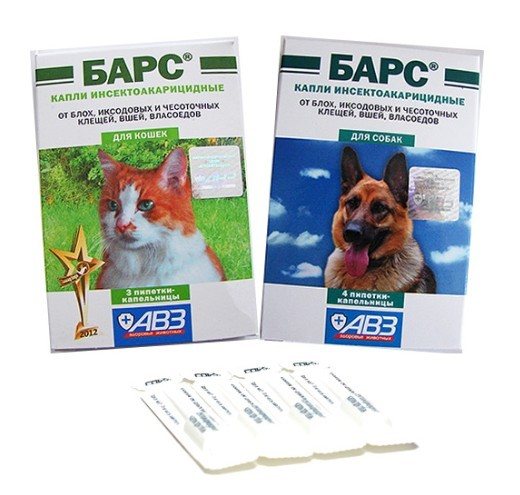

Means "Bars"
It is sold in 20 ml packs. The cost is about 150 rubles. The composition contains diazinon, prednisolone. This combination of substances has a destructive effect on insects, destroying both adults and larvae. "Bars" relieves inflammation, swelling, eliminates itching, promotes wound healing.
Contraindication is individual intolerance to any of the components.present in the composition, and perforation of the tympanic membrane. Ignoring the dosage will negatively affect the pet's well-being.
"Amitrazine Plus"
The drug is sold in packs of 10 ml, its cost is 75-85 rubles. The active ingredients are amitraz, decamethoxin.


Be sure to read:
Drops on the withers from worms for cats and cats: how to apply correctly, the best means, dosage
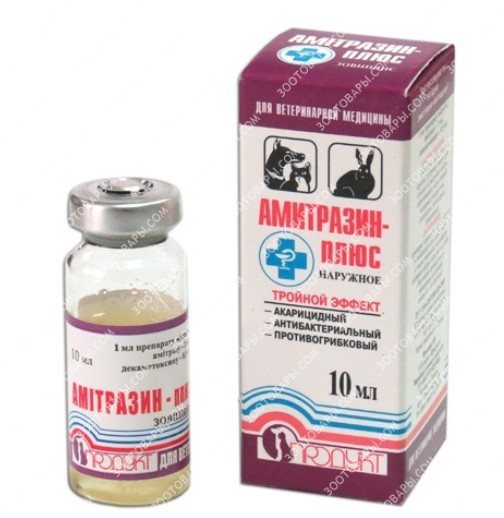

"Amitrazine Plus"
The combination of these substances has a depressing effect on adults and tick larvae, has antifungal and bactericidal effect, relieves inflammation and neutralizes possible infection.
The drug quickly penetrates the skin, the effect is noticeable after 1 treatment.The duration of therapy is 6-8 days. The only contraindication to use is individual intolerance.
Effective medicine "Otoferonol Gold"
Release form - drops, packaged in 10 ml. The cost of packaging is 150 rubles.
Main active ingredients:
- deltamethrin - synthetic pyrethroid, the action of which is aimed at blocking the nerve impulses of the insect, resulting in paralysis, and then death;
- cycloferon - anti-inflammatory component that eliminates infection, swelling, itching;
- propolis extract - a substance that accelerates wound healing.
"Otoferonol Gold" thanks to the complex effect, it improves the well-being of the pet after the first procedure.
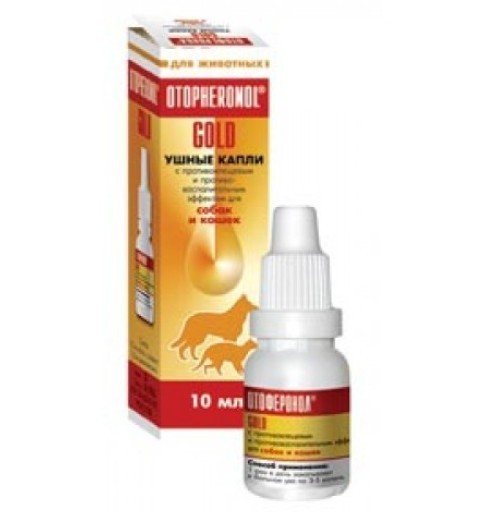

"Otoferonol Gold"
Contraindications for use:
- age less than 2 months;
- pregnancy;
- concomitant infectious diseases;
- feeding kittens;
- perforation of the tympanic membrane;
- individual intolerance.
Drops "Tsipam"
They are packaged in dropper bottles with a volume of 20 ml and cost 150-160 rubles each. The active ingredients are cypermethrin and amitraz. The drug quickly accumulates in a toxic concentration in the body of the parasite, which leads to its early death.
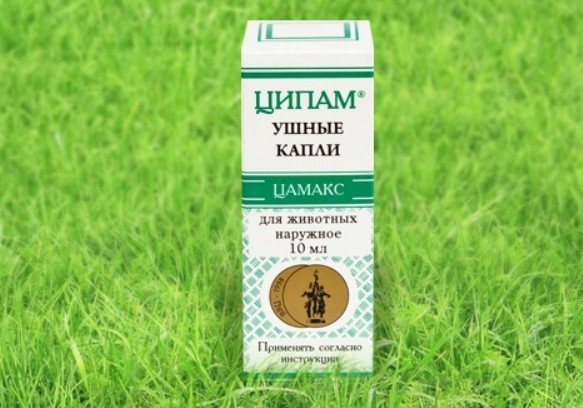

Drops "Tsipam"
To combat the parasite, the treatment is recommended to be carried out 2 times at intervals of 3-5 days according to the instructions. Instill 3-6 drops depending on the size of the pet.
Contraindications:
- pregnancy;
- feeding period;
- less than 6 weeks of age;
- concomitant infectious pathologies.
"Amit"
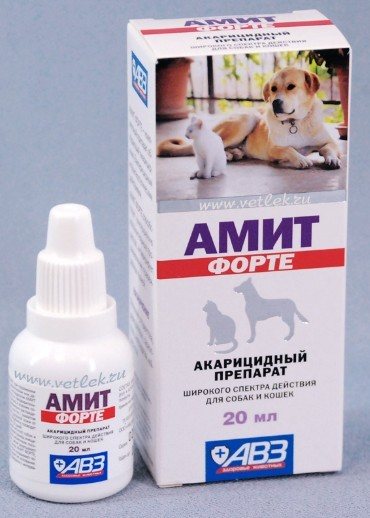

"Amit"
The medicine is sold in a dosage of 20 ml, the cost per package reaches 120-150 rubles. The active ingredient is amitraz, which has a depressing effect on parasites.
The excipients provide deep penetration into the skin and fast action. "Amit" relieves inflammation and itching, accelerates healing.
Treatment should be carried out according to the instructions until the unpleasant symptoms are completely eliminated at a frequency of 1 time in 5 days.
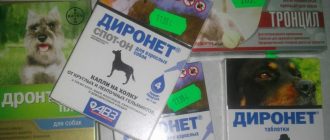

Be sure to read:
Dironet Spot-on ® (drops) for cats and dogs to eliminate ticks and fleas
Contraindications to use:
- concomitant infections in the body;
- weakened immunity;
- the period of pregnancy, feeding;
- less than 8 weeks of age.
Side effects
Amit for dogs is contraindicated in the following cases:
- puppies up to two months old;
- pregnant and lactating bitches;
- pets weakened by an infectious disease;
- dogs with an allergic reaction to the drug.
Individual intolerance to the components of this product is manifested by redness of the treated skin. In this case, it is necessary to wash off the drug with an antiseptic and select a quality analogue with a different composition.
No symptoms of drug overdose have been identified. When applied abundantly to the skin, part of the product is absorbed and begins to act on the mites. Residue drains or evaporates.
How to use various remedies for ear mites in cats
Before using the medicinal drops, it is recommended to first cleanse the inflamed ear from scabs, then drip the medicine into each auricle for 3-5 drops. If necessary, therapy should be repeated after 5-7 days.
Attention! Even if only one auricle is inflamed, the drug is still injected into both.
With a strong degree of damage, the method of application is to process it every other day, until the unpleasant signs of infection disappear.
List of drugs
Drugs of the following dosage forms are used:
Ivermek gel
The active ingredients are acaricide Ivermectin, an analgesic and wound-healing agent. Both organs of hearing are processed, even if one is affected, 1 ... 2 times, duplicating after 5 ... 7 days. Contraindicated in breeds sensitive to Ivermectin, convalescent and malnourished cats.
Amidel-gel
Active ingredients - acaricide, analgesic, antimicrobial agent, auxiliary wound-healing substances. Both channels are processed 1. 2 times, duplicating, after 5 ... 7 days. Contraindicated in kittens up to 2 weeks old, convalescent, sick.
Aversectin ointment
The active ingredient is Aversectin. To clean the ear from crusts, additional products are needed - lotions or Perhydrol. The wool is sheared. Apply ointment, fold the shell in half, massage the base of the ear. Contraindicated for breeds sensitive to Aversectin, kittens up to 2 months old, succumbing, lactating, convalescent, sick.
Surolan
Aurikan
Amitrazine
Ear drops. The active ingredients are acaricide Amitraz and Dimexide, which have antiseptic, anti-inflammatory and analgesic properties. The ear is folded and massaged. The treatments are repeated a week later until the symptoms disappear.
Ectodex
Ear drops based on Propolis and Sulfur. Preliminary cleaning of the auditory canal from secretions is required. Treatment consists of two or three treatments after 5-7 days. The medicine is contraindicated in sukotny, lactating, and also under one month old animals. Do not use the drug if the integrity of the tympanic membrane is broken.
Anandin plus
Ear drops. The main active ingredients are acaricide Permethrin, immunostimulant Anadine, antiseptic Gramicidin. Preliminary cleaning of the ears is carried out with the same drug that is used for treatment. The hearing organs are massaged after the instillation of the medicine. The therapy lasts 3-7 days. With a single pass of the use of Anandin, the course of treatment is resumed.
If the cat shakes its head, prevent splashing of drops with fixation. Contraindication - violation of the integrity of the tympanic membrane.
Ear drops, consisting of Amitraz and Prednisolone. The crusts are soaked with a swab soaked in Amit. The ears are treated twice a day. The course of treatment is 3 ... 5 days. If there is a secondary infection, the drug is changed. Contraindication - fat, lactation, age less than 2 months.
Deckt
Ear drops, consisting of Amitraz, Propolis and Dexamethasone. Apply once, with an interval of 5 ... 7 days. Number of treatments 2 ... 3. Contraindication - fat, lactation, age less than a month.
Pipette-shaped drops. The main component is the organophosphate disinfectant Diazinon.
After instilling the medicine, the ears are massaged. A week later, the processing is duplicated. The medicine should not be used by sukotny and lactating animals, as well as to animals under 10 weeks of age.
Mycodemocide
Drops. Consist of Sea buckthorn oil, Chlorophos, Isopropyl alcohol detergent. Processed once, repeated 7 days later, if necessary. Contraindicated in succulent and lactating animals, young animals under 10 weeks of age.
Ivermek spray
Analogue of Ivermek-gel. Injected into the ears twice with an interval of 3 ... 5 days. Dress the Elizabethan collar before the ear surface dries to avoid licking. The drug is not prescribed to animals under three months old, lactating, succulent, as well as cats of breeds hypersensitive to Ivermectin.
Acaromectin
The active ingredient is Ivermectin. The affected area is moistened abundantly. The processing is repeated after 8 ... 10 days. Requires 3 ... 4 injections. The Elizabethan collar is worn until the wetted surface dries. Contraindicated in sukotny, lactating and under one month old animals.
Neostoazan
An emulsion that is used to kill insects. The contents of the ampoule (1 ml) are dissolved in 0.2 ... 0.4 l of water and the auditory canal is abundantly moistened. A week later, the procedure is repeated.
Prevention measures
A parasite is easier to prevent than to cure.Any preparation based on acaricides has a depressing effect not only on insects, but also on the pet itself.
To avoid infection, it is recommended to adhere to the following prevention rules:
- Exclude contact with street and sick cats.
- Check your ears regularly for contamination.
- Carry out hygienic cleaning of the ears with special lotions.
- In dangerous periods of the year, use a tick and flea collar.
- Improve your pet's immunity with a balanced diet.
The reasons for the appearance of parasites
It must be said that the main reason for the appearance of such ticks in cats and cats is weak immunity. The tick can be transmitted in various ways: ● Through household items. ● Through infestation with fleas. ● From people through clothing and dirty hands. ● Subsequently contact with already infected animals.
The size of a cat's ear mite is no more than one millimeter. Therefore, this parasite is simply invisible to the naked eye. A mite in the auricle can survive for 25 days, which explains the frequent infection in cats.
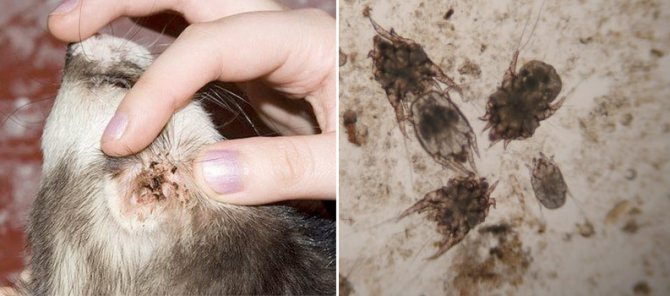

Concomitant therapy
During the treatment of an ear mite, it must be borne in mind that the parasite can spread to the cat's torso, therefore, in parallel with the treatment of the auricles, antiparasitic procedures for the whole body should be carried out. To do this, it is enough to apply a few drops of a special preparation to the pet's scruff or spray it.
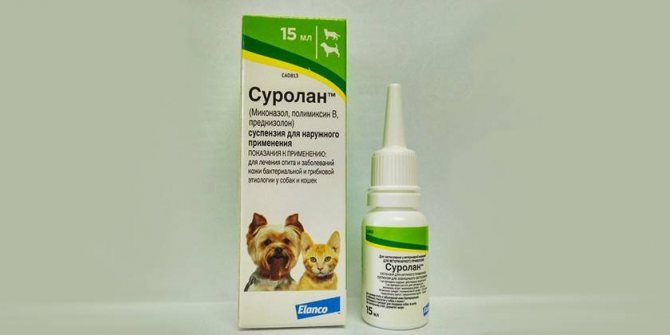

You should also take care of the furry pet's immune system. The stronger the immunity, the faster recovery will come, and the more chances you have to avoid re-infection. A cat's diet should contain a large amount of vitamins and be varied. Ready-made vitamin complexes can be added to the feed. It is also recommended to conduct a course of therapy with drugs that enhance the body's defenses - Gamavit, Tentravit.
How to prevent otodecosis
Even if there are seemingly clear signs of an ear mite, the cat should be shown to the veterinarian. Similar symptoms can appear with dermatoses, lichen, fungal and bacterial infections. In addition, there is another type of external microscopic parasite that lives on the ears of cats. Therefore, before starting treatment, a diagnosis is required.
The diagnosis is made on the basis of examination and microscopic examination of scrapings from the surface of the auricle. Under the microscope, the doctor will quickly identify the parasite and prescribe the appropriate treatment.


If there is no opportunity to conduct laboratory diagnostics, you can try the home method. This will require a black sheet of paper and a magnifying glass. You need to take some secretions from the inner surface of the pet's auricle and smear it on paper. If there is a parasite, then on the leaf it looks like a moving whitish dot.
The term of treatment for an ear mite depends on the degree of its distribution, the presence of concomitant diseases, and the general condition of the pet. An uncomplicated course of the disease can be cured within 1-3 weeks. If the pathology has led to complications, there is a secondary infection, then the treatment may take several months.
In most cases, tick damage to the ears of a cat can be prevented. To do this, you should adhere to the following preventive measures:
- periodically inspect the pet's ears for scratching, redness, swelling, scabs;
- regularly clean the external auditory canal;
- do not allow communication with unfamiliar animals;
- strengthen the cat's immune system.
An attentive attitude to your pet and a timely visit to a doctor will help to avoid health problems.
Infection routes
Interestingly, cats can only catch ear mites from another sick animal. This is due to the fact that the parasites themselves quickly die in nature without a host.
Veterinary practice shows that ear mites in cats can appear only when they come into contact with other animals on the street. The disease is transmitted from the mother to the kittens. There is a high risk of infection in those animals, whose owners often turn to specialized hotels. This is due to the fact that they are kept there in group rooms. It is this factor that does not guarantee that there will be no infected animal among them.
The source of infection is always another sick animal.
The ear mite feels equally comfortable on cats of any breed, regardless of the size of the coat and the prevailing habitat.
Diagnostics
For treatment, you need to make sure that the cat really has a tick, and not some other lesion. This is due to the fact that there is another disease that looks very much like otodectosis, refers to skin parasitosis, and is called notoedrosis, as it is caused by the Notoedres cati mite. It is for this reason for the treatment it is very important to pinpoint the source of the infection, as this will require their medications.
Mode of application
- Before starting treatment with the drug, thoroughly clean the cat's ears from scabs and crusts.
- Using a pipette, add the product to both ears, depending on the body weight of the animal (for medium-sized cats - 0.5 ml).
In order for the drug "Amitrazine" for cats to completely treat the entire affected surface and the ear canal, the ear must be folded in half lengthwise and gently massage its base.
If other areas on the cat's head are damaged, the drug should be rubbed into the affected area with a cotton swab. After a week, the treatment is repeated.
Contraindications: Dimexide intolerance, pregnancy.
Ways of infecting cats with a subcutaneous tick
Even animals that are never allowed to go outside can develop this disease. And for those who go there, the danger of infection increases many times over.
How does the infection take place?
- The source of the causative agent of the disease can be a sick animal - a cat or a dog.
- Close contact is not necessary, it is enough for a cat to walk where an infected animal has already passed.
- The tick can easily get on the clothes or shoes of the person who will bring it into the house.
- Even small kittens that are in the womb, if she is sick, can become infected with demodicosis.
If you do not vaccinate the animal and do not follow preventive measures, then the risk of infection increases many times. Animals that do not have a host are much more likely to be infected with a subcutaneous mite.
Symptoms of demodicosis in cats
Veterinarians believe that subcutaneous mites are present in almost all animals. For some cats, this turns into a disease, in others, he does not show himself in any way.
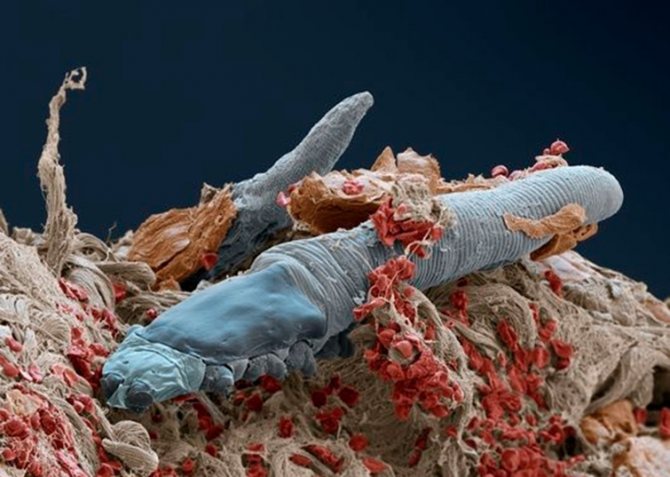

Symptoms of demodicosis in cats do not always appear brightly. Inattentive owners do not even suspect about the disease until the subcutaneous tick spreads to the entire body of the cat. What does a subcutaneous tick look like in cats? What should be alarming?
- Lethargy and apathetic appearance of the animal.
- Lack of appetite.
- Dandruff
- Dull coat. The animal has the so-called "demodectic glasses" - the hair in the eye area falls out. Areas heavily populated with ticks are also becoming bald.
- Incessant itching, which causes the cat to scratch the skin.
- At the sites of scratching, pustules or weeping wounds form.
If the animal has become restless, constantly scratching behind the ears or muzzle, while piteously meowing, one can suspect that it is a victim of a subcutaneous tick.
There is another type of mite that also lives under the skin of a cat - scabies. The disease is called notoedrosis, and its manifestations are similar to demodicosis. Animals are worried about itching, hair falls out.

